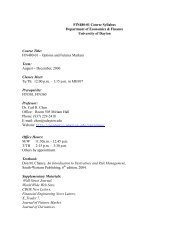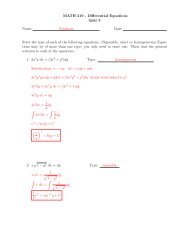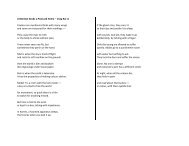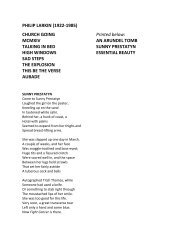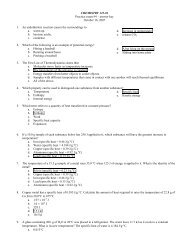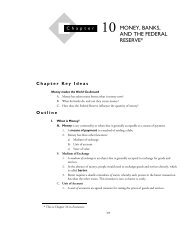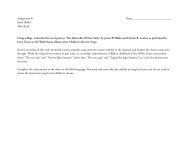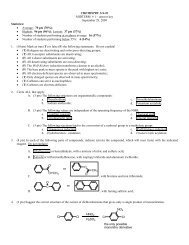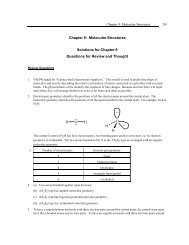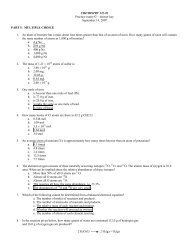Physics 206 Example Problems Newton's Laws of Motion
Physics 206 Example Problems Newton's Laws of Motion
Physics 206 Example Problems Newton's Laws of Motion
You also want an ePaper? Increase the reach of your titles
YUMPU automatically turns print PDFs into web optimized ePapers that Google loves.
That is I can conclude that the tensions in the two sides <strong>of</strong> the ropes are equal. Applying the second law<br />
in the y-direction gives,<br />
Fnet, y = m a y<br />
T1 sinθ + T2 sinθ − F = 0<br />
2 T sinθ − F = 0<br />
T = F<br />
2 sinθ =<br />
400<br />
2 sin( 3◦ N = 3820 N<br />
)<br />
The size <strong>of</strong> the force that the rope pull on the car with is the tension in the rope which has just been<br />
found to be 3820 N.<br />
B) To just move the car the acceleration has to be barely more that zero. So the net force is essentially<br />
zero still. The analysis <strong>of</strong> part A) still holds so,<br />
T = F<br />
2 sinθ =<br />
600<br />
2 sin( 4◦ N = 4300 N<br />
)<br />
Problem 1 1 . What size downward force F must be applied to lift the cart <strong>of</strong> weight 2000 N using the 4pulley<br />
apparatus shown below?<br />
F<br />
m<br />
Ceiling<br />
Solution . The tension in the rope going over the pulleys is constant throughout. Apply Newton’ s second<br />
law to each <strong>of</strong> the hanging pulleys. The upward force on each <strong>of</strong> these pulleys is 2 F. Since these pulleys<br />
do not accelerate ( and if the pulleys are nearly massless. . . ) the downward force on these pulleys must have<br />
size 2 F. This means that the tensions in each <strong>of</strong> the strings attached to the mass is 2 F. Therefore the<br />
net upwards force on the mass is 4 F. This force supports the weight <strong>of</strong> the mass so,<br />
4 F = W ⇒ F = W 2000 N<br />
= = 500 N<br />
4 4<br />
To lift the mass a force <strong>of</strong> 1 /4 the weight <strong>of</strong> the block must be applied. The pulley arrangement is essentially<br />
a force multiplier.<br />
Problem 1 2. A mass m hangs at the end <strong>of</strong> a massless string attached to the ro<strong>of</strong> <strong>of</strong> a truck. The<br />
motion is such that the string makes a constant angle θ with the vertical. What must be the acceleration<br />
<strong>of</strong> the truck for this situation to be possible. ( This forms the basis for a simple means to measure the<br />
acceleration <strong>of</strong> an object. )<br />
Solution: The forces that act on the mass are the tension in the string and the force due to the gravitational<br />
pull <strong>of</strong> the earth. With up as +y and the direction <strong>of</strong> the acceleration as +x, these forces can be<br />
written as,<br />
Frop<br />
e = T sinθ xˆ + T cosθyˆ FG<br />
= − m gE yˆ<br />
Applying Newton’ s second law in the y-direction gives,<br />
Fnet, y = m a y = 0<br />
T cosθ − m gE = 0<br />
m gE<br />
T =<br />
cosθ<br />
8




